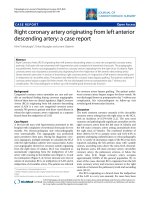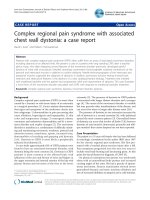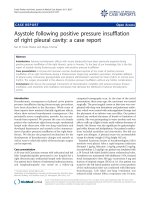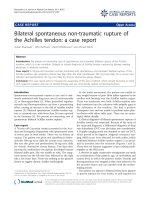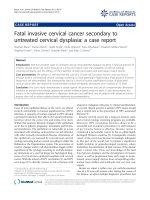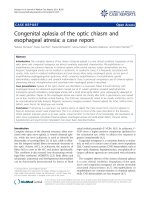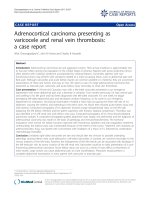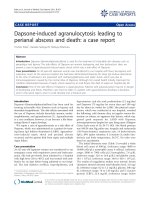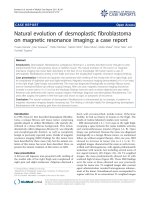Báo cáo y học: "Complex regional pain syndrome with associated chest wall dystonia: a case report" ppt
Bạn đang xem bản rút gọn của tài liệu. Xem và tải ngay bản đầy đủ của tài liệu tại đây (217.68 KB, 4 trang )
CASE REP O R T Open Access
Complex regional pain syndrome with associated
chest wall dystonia: a case report
David J Irwin
*
and Robert J Schwartzman
Abstract
Patients with complex regional pain syndrome (CRPS) often suffer from an array of associated movement disorders,
including dystonia of an affected limb. We present a case of a patient with long standing CRPS after a brachial
plexus injury, who after displaying several features of the movement disorder previously, developed painful
dystonia of chest wall musculature. Detailed neurologic examination found palpable sustained contractions of the
pectoral and intercostal muscles in addition to surface allodynia. Needle electromyography of the intercostal and
paraspinal muscles supported the diagnosis of dystonia. In addition, pulmonary function testing showed both
restrictive and obstructive features in the absence of a clear cardiopulmonary etiology. Treatment was initiated
with intrathecal baclofen and the patient had symptomatic relie f and improvement of dystonia. This case illustrates
a novel form of the movement disorder associated with CRPS with response to intrathecal baclofen treatment.
Keywords: complex regional pain syndrome, dyston ia, movement disorder, dyspnea
Background
Complex regional pain syndrome (CRPS) is most often
causedbyafractureorsofttissueinjuryofanextremity
or a surgical procedure [1]. Factor analysis demon strates
that signs and symptoms of the syndrome cluster into
four subgroups: 1) abnormalitiesinpainprocessingthat
cause allodynia, hyperalgesia and hyperpathia; 2) skin
color and temperature change; 3) neurogenic edema,
vasomotor and sudomotor abnor malities; and 4) a move-
ment disorder and trophic changes [2]. The movement
disorder is manifest as a co mbination of difficulty initiat-
ing and maintaining movement, weakness, postural and
intention tremor, myoclonus, spasm, increased tone,
abnormalities of reaching and grasping and dystonia
[3,4]. Dystonia in CRPS is most likely a peripherally
induced, focal dystonia [5].
In one study approximately 62% of CRPS patients were
found to have an associated movement disorder, with
dystonia being the most common [6]. Dystonia in CRPS
patients is most common in the affected limb, with
adduction of the arm and flexion of wrist and fingers in
the upper extremity and internal rotation of the hip with
plantar flexion and inversion of the foot in the lower
extremity [3]. The presence of dystonia in CRPS patients
is associated with longer disease duration and a younger
age [6]. The onset of the movement disorder is variable
but may precede other manifestations of the disease, and
can occur five years or longer after disease onset [3,6].
The presence of dystonia in one extremity increases the
risk of dystoni a in a second extremity [6], with ipsilateral
spread the most common pattern [3]. Generalized forms
of dystonia can occur that involve all limbs [7,8]; however
dystonia of axial muscles (intercostal, pectoralis and obli-
que muscles) that causes dyspnea has not been reported.
Case Presentation
The patient is a 51-year-old female who has been followed
in neurologic consultation by the author (RJS) since 1987
for her chronic regional pain syndrome. She first pre-
sented with a brachial plexus traction injury after a fall.
Pain symptoms progressed over the next two years to
include total body burning and lancina ting pains. At this
point she had all factors for diagnosis of CRPS [9].
On physical examination the patient was moderately
obese with an anteroflexed body posture and increased
carrying angles of the arms. She had a paucity of sponta-
neous movement. Sens ory examination sh owed severe
generalized dynamic and static mechano a llodynia and
loss of surround inhibition to pinprick and a cold stimulus.
* Correspondence:
Drexel University College of Medicine, Department of Neurology,
Philadelphia, PA, USA
Irwin and Schwartzman Journal of Brachial Plexus and Peripheral Nerve Injury 2011, 6:6
/>JOURNAL OF BRACHIAL PLEXUS AND
PERIPHERAL NERVE INJURY
© 2011 Irwin and Schwartzman; licensee BioMed Central Ltd. This is an Open Access article distributed under the terms of the Creative
Commons Attribution License (http://creativecommon s.org/licenses/by/2.0), which permits unrestricted use, distribut ion, and
reproduction in any medium, provided the original work is properly cited.
In addition, she had severe generalized deep muscle sensi-
tization and joint pain. She had hyperalgesia to pinprick
and “wind up” as well as cold allodynia in all quadrants of
her body. She had longstanding chest pain in the distribu-
tion of the intercostobrachial nerve [10]. Autonomic invol-
vement was demonstrated by cold extremities and
generalized hyperhidrosis and was associated with moder-
ate neurogenic edema in the lower extremities and livedo
reticularis of the skin. Dystonic posturing of the lower
extremity was noted early during a few visits and was evi-
denced by internal rotation of th e hip and plantar flexion
and inversion of the foot. In addition to overt dystonia, the
patient developed ambulatory dysfunc tion due to weak-
ness and difficulty initiating movements. On one occasion
she noted her legs did “ not feel like hers.” She had diffi-
culty initiating and maintaining fine movements in all
extremities. On one visit a postural and intent ion t remor
of the hands and head was noted.
She had failed numerous surgical and medical interven-
tions and developed opiate dependency requiring high
doses of intrathecal dilaudid via a subcutaneous pump.
Other medical problems included adrenal insufficiency,
obstructive sleep apnea that required maintenance on
nocturnal bi-level positive airway pressure, chronic
gastroparesis, chronic elevation of the right hemi-
diaphragm, and hypothyroidism.
Approximately twenty-four years after the onset of her
CRPS, the patient began having respiratory symptoms of
dyspnea on exertion. Palpation of the chest wall s howed
restricti ve chest expansion and sustained contractions of
the intercostal musculature, consistent with dystonia. Elec-
tromyography (EMG) of the transverses thoraces muscles
and paraspinal muscles at T6 and T10 showed normal
insertional activity and motor unit morphology. During
neurophysiologic testing there was an inability to relax
these muscles voluntarily by the patient.
Initial pulmonary function testing showed a mixed
restrictive and obstructive picture with a response to
bronchodilators (Table 1). Spirometry study met American
thoracic society criteria for acceptability [11], with the
exception of forced vital capacity on the first study due to
fatigue. CT scanning of the chest did not display any fea-
tures of interstitial lung disease. Echocardiogram sh owed
grade I diastolic dysfunction with no structural heart,
valve disease, or pulmonary hypertension.
After receiving a five -day continuous intravenous
sub-anesthetic dose of ketamine by infusion (40 mg/hr;
midazolam 4 mg/6 hr; 0.1 mg of clonidine), her intrathecal
dilaudid was gradually weaned from 79 mg/day to 21 mg/
day. In addition, intrathecal baclofen was added at an initial
dose of 75 μg/day. Baclofen was up titrated by approxi-
mately 50 μg/day every two weeks to a final dose of 600 μg/
day. The patient experienced symptomatic relief of her
chest wall discomfort and dyspnea beginning at doses o f
125 μg of baclofen per day. Chest wall dystonia was much
improved on serial neurologic examinations. Pulmonary
function testing results were not significantly changed after
baclofen treatment (Table 1). She was maintained at a dose
of 600 μg/day of intrathecal baclofen and has been asymp-
tomatic in regard to lethargy, weakness, nausea, headaches,
or psychosis.
Conclusions
To our knowledge, this is the first report of dystonia of the
chest wall musculature associated with CRPS. The electro-
diagnostic evidence of dystonia was limited to patient-
dependent factors, as the EMG testing showed normal
motor unit activation and morphology. It should be noted
that the EMG was performed while the patient was receiv-
ing 425 μg/day of intrathecal baclofen, which could affect
motor unit activation. A neurophysiologic study of dysto-
nia in CRPS patients found a similar inability to alter mus-
cle activity voluntarily, in addition to decreased inhibition
from activation of antagonist muscle groups [12]. One
could argue that the observed inability to relax the chest
was musculature was psychogenic; however, voluntary sus-
tained contraction of these axial muscle groups would be
very difficult to perform compared to an extremity. In
addition, this patient did not display pseudoneurological
signs others have argued to be present in CRPS [13].
The significance of t he chest w all dystonia in regards
to pulmonary symptoms is unclear, but most likely
Table 1 Pulmonary function testing results before and after intrathecal baclofen treatment
FVC FEV1 FEF 25-75% PEF TLC RV DLCO
Study 1†
Pre-Bronchodilator
1.83 L
(44% Ref)
1.60 L
(49% Ref)
2.20 L/sec
(73% Ref)
5.34 L/sec
(71% Ref)
2.71 L
(45% Ref)
0.88 L
(40% Ref)
12.20 mL/mmHg/min (44%
Ref)
Post
-Bronchodilator
2.06 L
(50% Ref)
1.78 L
(54% Ref)
2.44 L/sec
(81% Ref)
4.62 L/sec
(62% Ref)
NA NA NA
Study 2††
Pre-Bronchodialtor
1.95 L
(47% Ref)
1.57 L
(49% Ref)
1.59 L/sec
(53% Ref)
4.74 L/sec
(64% Ref)
3.07 L
(52% Ref)
1.10 L
(50% Ref)
11.00 mL/mmHg/min (36%
Ref)
Post
-Bronchodilator
2.18 L
(53% Ref)
1.79 L
(55% Ref)
1.97 L/sec
(66% Ref)
4.89 L/sec
(66% Ref)
NA NA NA
† Patient intrathecal medication dose at time of study: Baclofen 0 μg/day, Dilaudid 26.5 mg/day.
†† Patient intrathecal medication dose at time of study: Baclofen 400 μg/day, Dilaudid 21.5 mg/day.
Irwin and Schwartzman Journal of Brachial Plexus and Peripheral Nerve Injury 2011, 6:6
/>Page 2 of 4
contributes in part to the restrictive pulmonary function
pattern observed. Patients with idiopathic and secondary
dystonia have been noted to have excessive contractions
of the diaphragm and upper airways contributing to
symptoms of dyspnea [14]. This patient also had
obstructive features and a response to bronchodilators,
which most likely represen ts concomitan t asthmatic dis-
ease. There was no intrinsic disease of the lung parench-
yma on CT scanning that could be responsible for her
obstructive and restrictive pulmonary function. Vocal
cord involvement as a cause for her dyspnea was also
unlikely, as there was no dysphonia. Her body habitus,
chest wall pain, and p aralysis of the right hemi-dia-
phragm can also contribute to restrictive lung disease.
The diaphragm paralysis in this patient is most likely
another manifestation of dystonia as spasmodi c contrac-
tion of the diaphragm may be seen in dystonic patients
[14].
The mechanism of dystonia in CR PS is not completely
understood but is generally thought to involve neural cir-
cuits that mediate sensory-motor integration [15-17].
Recent studies demonstrate i mpaired inhibition both at
cortical and spinal cord levels [18-20]. Present evidence
suggests that a major component of the mechanism of
dystonia in CRPS involves disinhibition o f painful noci-
ceptive withdrawal reflexes in the spinal cord [6]. These
reflexes are initiated by activity i n C and A-delta primary
pain fibers that colocalize vasoactive neuropeptides with
glutamate and are also pivotal in neurogenic inflamma-
tion [21]. Substance P is released from pain afferents and
activates NK1 receptors on lamina I neurons of the dor-
sal horn that is important in the induction of long term
potentiation of these pain transmission neurons [22].
Evidence of spinal cord inflammation has bee n demon-
strated in CRPS patients who have increased levels of
inflammatory cytokines in their spinal fluid [23,24].
Pathologic examination of a severe longstanding CRPS
patient has shown microglial and astrocytic activation
most prominent at the segmental level of injury, but also
as a gradient spr ead throughout the spinal cord bilater-
ally[25].Itispossiblethatthis inflammatory activation
of the spinal cord resulted in dystonia of the axial muscu-
lature through di sinhibition of GABAergic inhib itory
neuron s of the dorsal horn at thoracic levels mediated by
SP and inflammatory cytokines. The presented patient
has suffered with CRPS for over twenty years and the one
autopsied had a six year course suggesting that axial dys-
tonia is a late manifestation of the syndrome.
Intrathecal baclofen is effective in treatment of the limb
dystonia of CRPS at a mean dose of 415 μg/day [26]. Our
patient responded at 600 μg/day. Symptomatic improve-
ment from intrathecal baclofen implicates spinal cord
involvement in this form of dystonia. Its greatest concen-
tration is in the dorsal horn of th e spinal cord in primary
afferent fibers [27]. The axial dystonia seen in this patient
suggests a link between immune mediated cytokine
release and substance P activation of nocifensor reflexes
in the thoracic cord in the axial dystonia of CRPS.
Consent
Written informed consent was obtained from the patient
for publication of this case report. A copy of the written
consent is available for review by the Editor-in-Chief of
this journal
Acknowledgements
There was no private or public funding for this study.
Authors’ contributions
RJS formulated the project. DI and RJS contributed in taking the patient
history, physical exam, and preparation of the manuscript. All authors read
and approved the final manuscript.
Competing interests
The authors declare that they have no competing interests.
Received: 1 March 2011 Accepted: 26 September 2011
Published: 26 September 2011
References
1. Schwartzman RJ, Patel M, Grothusen JR, Alexander GM: Efficacy of 5-day
continuous lidocaine infusion for the treatment of refractory complex
regional pain syndrome. Pain Med 2009, 10(2):401-412.
2. Harden RN, Bruehl S: Diagnostic criteria: the statistical derivation of the
four criterion factors. In CRPS: Current Diagnosis and Therapy. Edited by:
Wilson, PR, Stanton-Hicks, MD, Harden, RN. Seattle: IASP Press; 2005:45-58.
3. Schwartzman RJ, Kerrigan J: The movement disorder of reflex
sympathetic dystrophy. Neurology 1990, 40(1):57-61.
4. Van Hilten JJ, Blumberg HPD, Schwartzman RJ: Factor IV: Movement
disorders and dystrophy: clinical and pathophysiological aspects. In
CRPS: Current Diagnosis and Therapy. Edited by: Wilson, PR, Stanton-Hicks,
MD, Harden, RN. Seattle: IASP Press; 2005:45-58.
5. Schott GD: Peripherally-triggered CRPS and dystonia. Pain 2007, 130:203-207.
6. van Rijn MA, Marinus J, Putter H, van Hilten JJ: Onset and progression of
dystonia in complex regional pain syndrome. Pain 2007, 130(3):287-293.
7. van Hilten JJ, van de Beek WJ, Roep BO: Multifocal or generalized
dystonia in complex regional pain syndrome: a distinct clinical entity
associated with HLA-DR 13. Ann Neurol 2000, 48:113-116.
8. van Hilten JJ, van de Beek WJ, Vein AA, van Dijk JG, Middelkoop HA:
Clinical aspects of multifocal or generalized tonic dystonia in reflex
sympathetic dystrophy. Neurol 2001, 56:1762-1765.
9. Harden RN, Bruehl S, Stanton-Hicks M, Wilson PR: Proposed new
diagnostic criteria for complex regional pain syndrome. Pain med 2007,
8:326-331.
10. Rasmussen J, Grothusen JR, Rosso AL, Schwartzman RJ: Atypical chest pain:
evidence of intercostobrachial nerve sensitization in complex regional
pain syndrome. Pain Phys 2009, 12:e329-e324.
11. Standardization of spirometry- 1987 update: Official statement of the
American Thoracic Society. Respir Care 1987, 32(11):1039-1060.
12. van de Beek WJ, Vein A, Hilgevoord AA, van Dijk JG, van Hilten BJ:
Neurophysiologic aspects of patients with generalized or multifocal
tonic dystonia of reflex sympathetic dystrophy. J Clin Neurophysiol 2002,
19(1):77-83.
13. Verdugo R, Ochoa JL: Abnormal movements in complex regional pain
syndrome: assessment of their nature. Muscle Nerve 2000, 23:198-205.
14. Braun N, Abd A, Baer J, Blitzer A, Stewart C, Brin M: Dyspnea in dystonia: a
functional evaluation. Chest 1995, 107(5):1309-1316.
15. Mink JW: Abnormal circuit function in dystonia. Neurol 2006, 66(7)
:959.
16.
Huang YZ, Trender-Gerhard I, Edwards MJ, et al: Motor system inhibition in
dopa-responsive dystonia and its modulation by treatment. Neurol 2006,
66(7):1088-1090.
Irwin and Schwartzman Journal of Brachial Plexus and Peripheral Nerve Injury 2011, 6:6
/>Page 3 of 4
17. Tisch S, Limousin P, Rothwell JC, et al: Changes in forearm reciprocal
inhibition following pallidal stimulation for dystonia. Neurol 2006,
66(7):1091-1093.
18. van de Beek WJ, Vein A, Hilgevoord AJ, van Dijk G, van Hilten B:
Neurophysiologic aspects of patients with generalized or multifocal
tonic dystonia of reflex sympathetic dystrophy. J Clin Neurophysiol 2002,
19(1):77-83.
19. Schouten AC, Van de Beek WJ, Van Hilten JJ, Van der Helm FC:
Proprioceptive reflexes in patients with reflex sympathetic dystrophy.
Exp Brain Res 2003, 151(1):1-8.
20. Schwenkreis P, Janssen F, Rommel O, et al: Bilateral motor cortex
disinhibition in complex regional pain syndrome (CRPS) type I of the
hand. Neurol 2003, 61(4):515-519.
21. Weber M, Birklein F, Neundorfer B, Schmelz M: Facilitated neurogenic
inflammation in complex regional pain syndrome. Pain 2001,
91(3):251-257.
22. Schouenborg J: Learning in sensorimotor circuits. Curr Opin Neurobiol
2004, 14(6):693-697.
23. Alexander GM, van Rijn MA, van Hilten JJ, Perreault MJ, Schwartzman RJ:
Changes in cerebrospinal fluid levels of pro-inflammatory cytokines in
CRPS. Pain 2005, 116:213-219.
24. Alexander GM, Perreault MJ, Reichenberger ER, Schwartzman RJ: Changes
in immune and glial markers in the CSF of patients with complex
regional pain syndrome. Brain Behav. Immun 2007, 21:668-676.
25. Del Valle L, Schwartzman RJ, Alexander G: Spinal cord histopathological
alterations in a patient with complex regional pain syndrome. Brain
Behav. Immunity 2009, 23:85-91.
26. van Rijn MA, Munts AG, Marinus J, Voormolen JHC, de Boer KS, Teepe-
Twiss IM, van Dasselaar NT, Delhaas EM, van Hilten JJ: Intrathecal baclofen
for dystonia of complex regional pain syndrome. Pain 2009, 143:41-47.
27. Malcangio M, Bowery NG: GABA and its receptors in the spinal cord.
Trends Pharmacol Sci 1996, 17:457-462.
doi:10.1186/1749-7221-6-6
Cite this article as: Irwin and Schwartzman: Complex regional pain
syndrome with associated chest wall dystonia: a case report. Journal of
Brachial Plexus and Peripheral Nerve Injury 2011 6:6.
Submit your next manuscript to BioMed Central
and take full advantage of:
• Convenient online submission
• Thorough peer review
• No space constraints or color figure charges
• Immediate publication on acceptance
• Inclusion in PubMed, CAS, Scopus and Google Scholar
• Research which is freely available for redistribution
Submit your manuscript at
www.biomedcentral.com/submit
Irwin and Schwartzman Journal of Brachial Plexus and Peripheral Nerve Injury 2011, 6:6
/>Page 4 of 4
